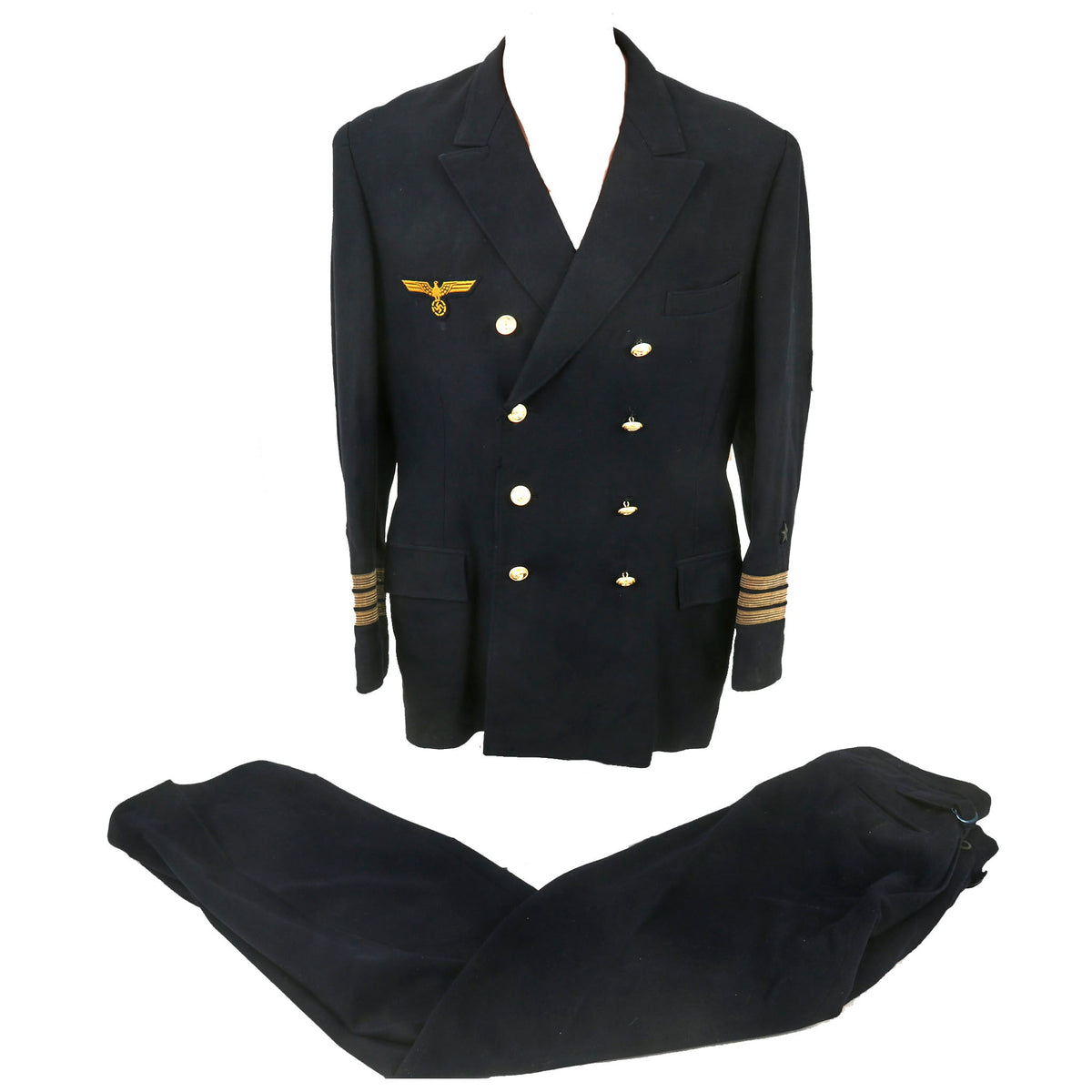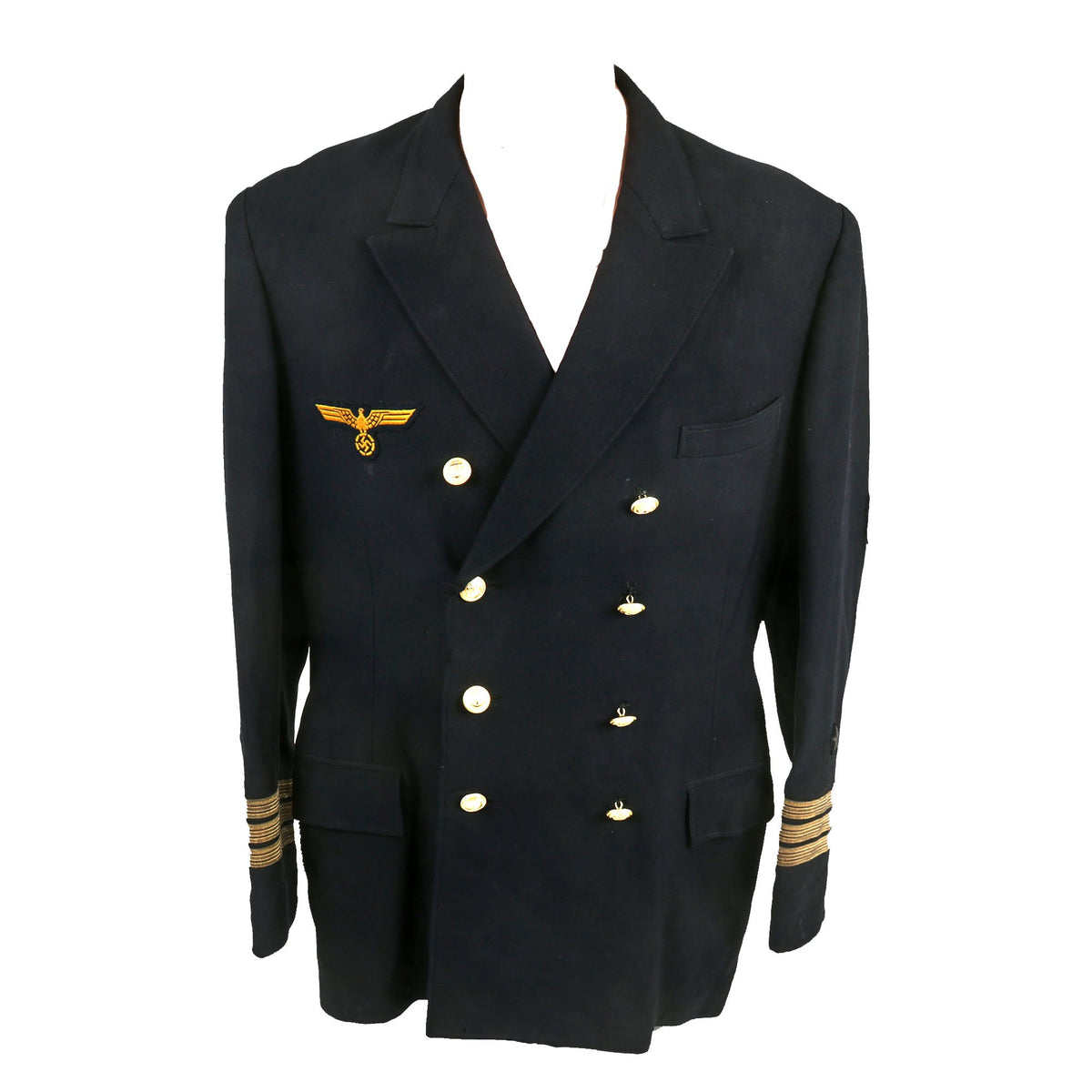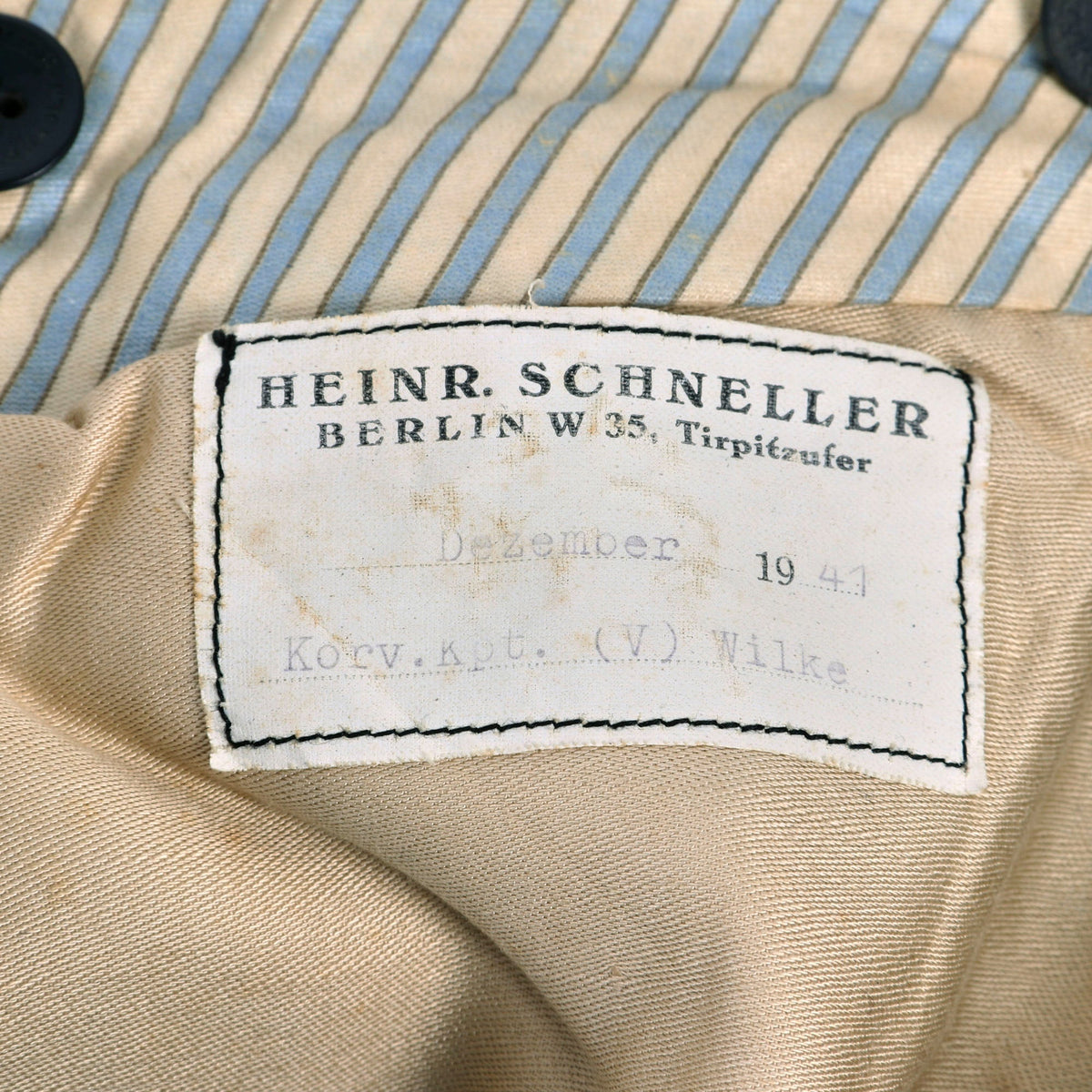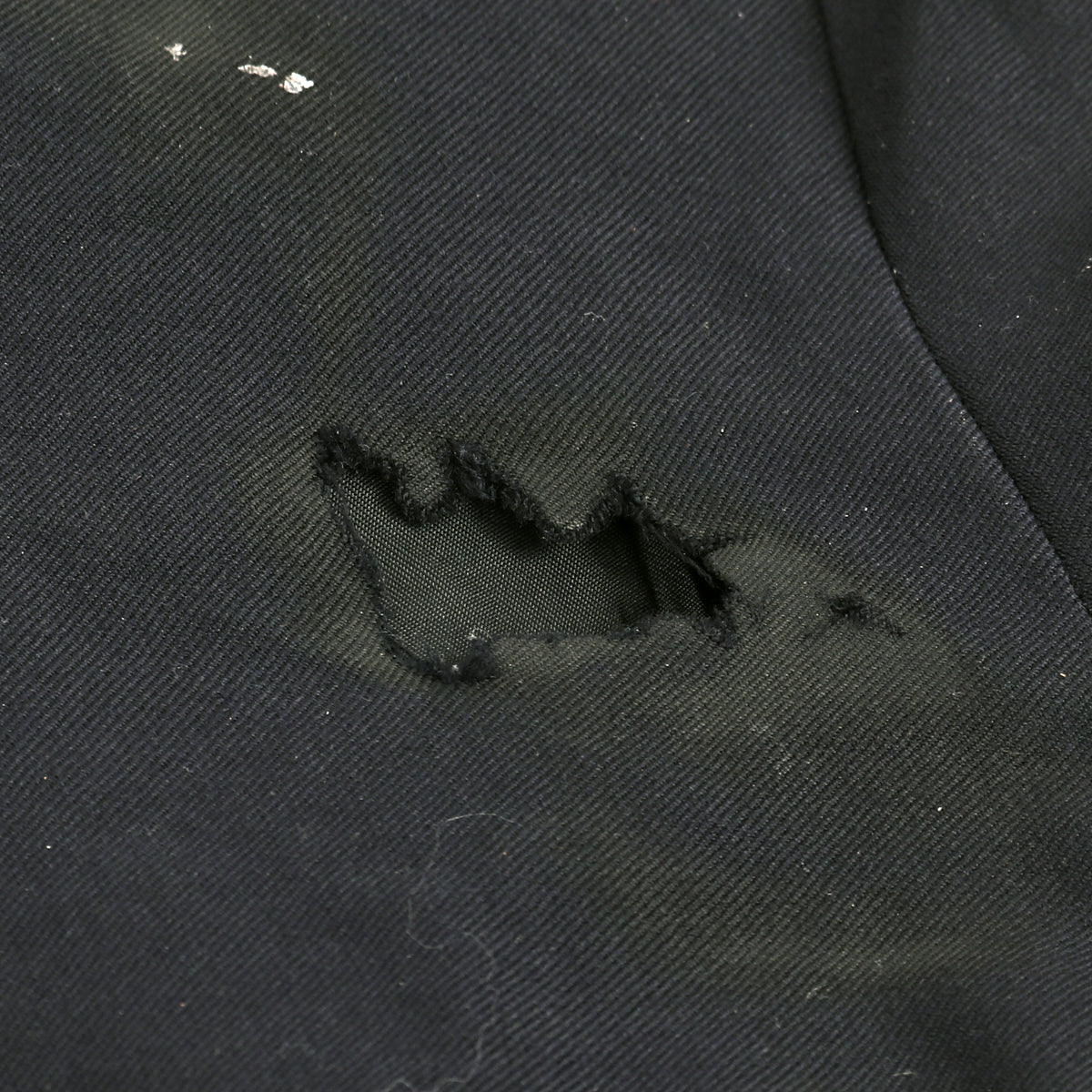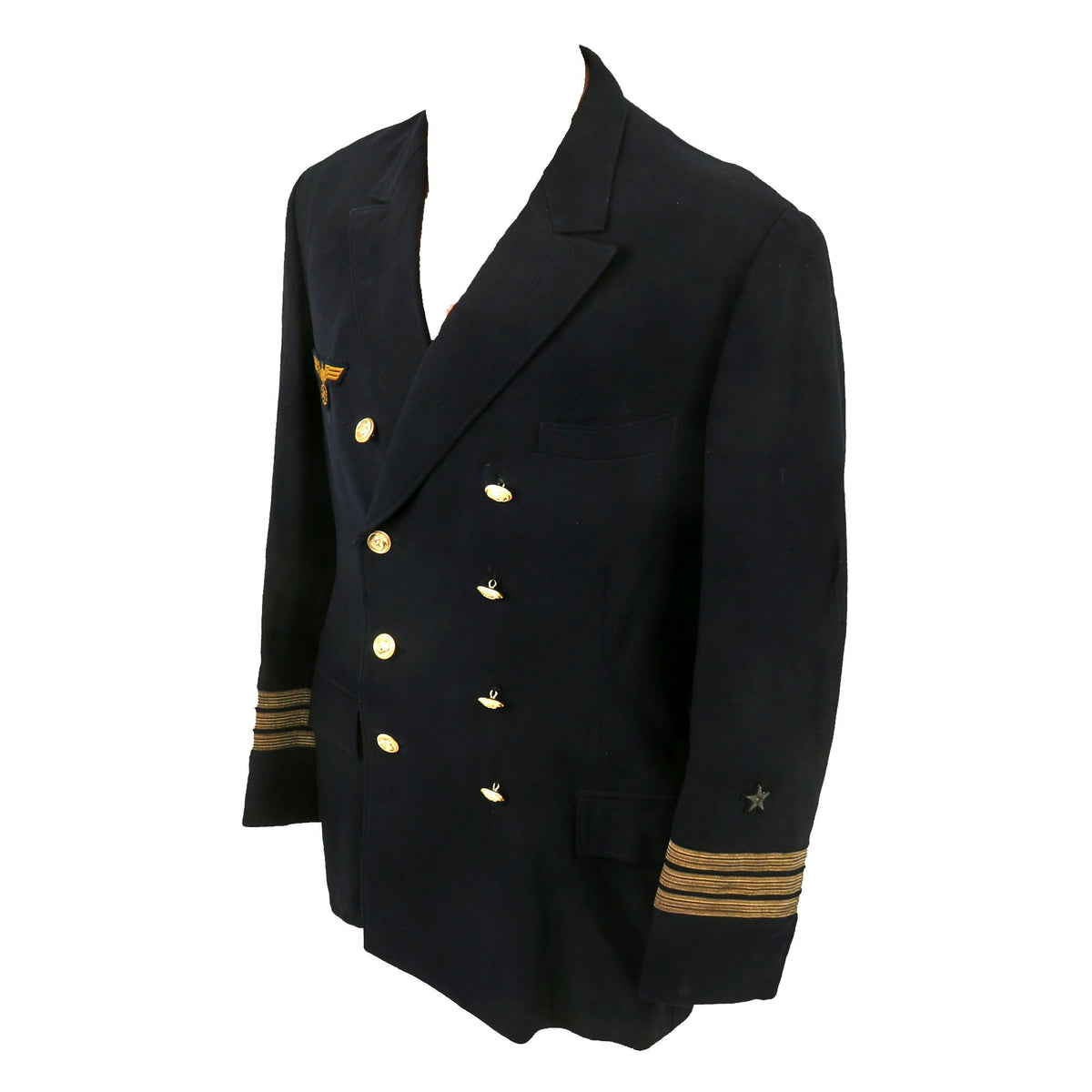Original German WWII 1941 Dated Named Kriegsmarine Korvettenkapitän Officer’s Uniform – Reefer Jacket & Trousers Original Items
$ 995,00 $ 248,75
Original Item: Only One Available. German Naval uniforms and headgear were based on the traditional designs that date back to the creation of the Prussian Navy in 1848. The uniforms and headgear did evolve during the interim years, many items used during the Third Reich era would still have been quite recognizable to the Imperial sailor.
The Reefer jacket was a basic uniform item intended for all ranks, with minor variations, and followed the basic design of the Imperial German Navy Reefer jacket. Officers and certain senior NCO ranks were responsible for purchasing their own uniforms and headgear and as a result, were allotted a clothing allowance through the Offizier Kleiderkasse der Kriegsmarine, (Officer’s Clothing Account of the Navy). Although enlisted personnel were issued their uniforms and headgear from government supplies, they were also permitted to purchase privately tailored items, but the price may have been restrictive. Generally speaking officers bought nicer quality, private purchase uniform items, but they could also choose to buy their uniforms directly from the military clothing depots.
This is a lovely Named Kriegsmarine Korvettenkapitän Officer’s Uniform Set, consisting of the standard Navy Blue “Reefer” jacket and Trousers. The jacket is unmarked, but the trousers are dated Dezember 1941 and named to Korv.Kpt. (V) Wilke. Officer’s were responsible for purchasing their own uniforms, so this is a bespoke set, made for Wilke.
The jacket in the set is a very good condition high quality private purchase three quarter length Officer’s Reefer Jacket, with navy blue wool construction. The double breasted style jacket features fold back, peak lapels and a lay down collar and has two, vertical parallel rows of four Kriegsmarine “Anchor” front closure buttons with corresponding button eyelets on both the left and right front panels. The top button on each side is ornamental and not functional. All marked on the back with the “Barred A” trademark of F. W. Assmann & Söhne of Lüdenscheid, a well-known manufacturer of buttons and other clothing accoutrements.
The right breast has a machine embroidered Kriegsmarine national eagle, made from gold celleon thread woven into a navy blue cut out blue wool base. The eagle is neatly hand stitched to the jacket. The jacket has two, horizontal slash, front hip pockets with straight edged flaps. The sleeves have straight cut, non-adjustable cuffs and each sleeve has three horizontally ribbed, woven gilt wire horizontal rank tress strip. The tress strips features two raised horizontal bars and a recessed crosshatch pattern. The tress strips are machine stitched in position and would been applied at the time the jacket was manufactured as they are inserted into the reverse sleeve seam. The sleeves also have a small, hand embroidered officer’s “star” insignia on each side.
The three rows of tress sleeve lace under a star indicate the line officer rank of Korvettenkapitän (Corvette Captain), equivalent to a U.S. Navy Lieutenant Commander. As is relatively standard there are no shoulder boards, which were often not used on this type of jacket, as the sleeve insignia made them redundant.
The interior of the jacket is fully lined in black rayon with white and blue striped rayon sleeves. The lining has horizontal slash pockets to both the left and right front breast panels. There is no maker marking that we can find, so this was almost certainly a bespoke example made for this particular officer at a local tailor. Condition is very good, but it does show wear from service, with an approximately 1 inch wide hole worn through the outer shell on the back, and other signs of use. The insignia is all in great shape, with the expected oxidation to the bullion tress loops on the sleeves.
The trousers are relatively standard, and bear a makers label from HEINR. SCHNELLER / BERLIN W35, Tirpitzufer, which also has the name and date mentioned previously. The trousers are constructed from lovely navy blue felt style wool, and feature two vertical slash pockets on the sides of the waist, as well as two horizontal slash pockets on the seat, which have button closures. The front closure features a four button fly with one side button, and a “Fire blued” steel top securing hook. There are also waist adjustment straps on the rear, which feature fire blued steel buckles. The interior shows some rayon reinforcement around the waist, and pockets made from a cotton rayon blend. All of the buttons are plastic / bakelite, and are maker marked. The trousers are in really great condition, and would be hard to improve upon. Aside from a few small moth holes, they don’t look to have seen much use at all.
This is a wonderful example of a WWII German Kriegsmarine Reefer Jacket, complete with the correct named and dated trousers. Comes more than ready for further research and display!
Approximate Measurements:
Collar to shoulder: 10″
Shoulder to sleeve: 26”
Shoulder to shoulder: 16”
Chest width: 21″
Waist width: 19″
Hip width: 20″
Front length: 33.5″
Pants:
Waist: 15.5″
Inseam: 30″
In the Imperial German Navy and Kriegsmarine the Korvettenkapitän (Corvette Captain) was the lowest officer rank of the senior officer’s rank group. The rank insignia consisted of shoulder strap and sleeve stripes. Shoulder straps had to be worn on uniform jackets and consisted of twisted silver-braids (without pip/star) on padding in navy blue weapon color. Cuff insignia consisted of three stripes, and a five-point naval star above. The sleeve rings encircled the lower cuffs. In the case of specialized officers, a corps insignia would replace the star.
The Kriegsmarine was the navy of NSDAP Germany from 1935 to 1945. It superseded the Imperial German Navy of the German Empire (1871–1918) and the inter-war Reichsmarine (1919–1935) of the Weimar Republic. The Kriegsmarine was one of three official branches, along with the Heer and the Luftwaffe, of the Wehrmacht, the German armed forces from 1935 to 1945.
In violation of the Treaty of Versailles, the Kriegsmarine grew rapidly during German naval rearmament in the 1930s. The 1919 treaty had limited the size of the German navy and prohibited the building of submarines.
Kriegsmarine ships were deployed to the waters around Spain during the Spanish Civil War (1936–1939) under the guise of enforcing non-intervention, but in reality supported the Nationalists against the Spanish Republicans.
In January 1939, Plan Z, a massive shipbuilding program, was ordered, calling for surface naval parity with the British Royal Navy by 1944. When World War II broke out in September 1939, Plan Z was shelved in favor of a crash building program for submarines (U-boats) instead of capital surface warships, and land and air forces were given priority of strategic resources.
The Commander-in-Chief of the Kriegsmarine (as for all branches of armed forces during the period of absolute NSDAP power) was Adolf H, who exercised his authority through the Oberkommando der Marine (“High Command of the Navy”).
The Kriegsmarine’s most significant ships were the U-boats, most of which were constructed after Plan Z was abandoned at the beginning of World War II. Wolfpacks were rapidly assembled groups of submarines which attacked British convoys during the first half of the Battle of the Atlantic but this tactic was largely abandoned by May 1943 when U-boat losses mounted. Along with the U-boats, surface commerce raiders (including auxiliary cruisers) were used to disrupt Allied shipping in the early years of the war, the most famous of these being the heavy cruisers Admiral Graf Spee and Admiral Scheer and the battleship Bismarck. However, the adoption of convoy escorts, especially in the Atlantic, greatly reduced the effectiveness of surface commerce raiders against convoys.
Following the end of World War II in 1945, the Kriegsmarine’s remaining ships were divided up among the Allied powers and were used for various purposes including minesweeping. Some were loaded with superfluous chemical weapons and scuttled.
Fast Shipping with Professional Packaging
Thanks to our longstanding association with UPS FedEx DHL, and other major international carriers, we are able to provide a range of shipping options. Our warehouse staff is expertly trained and will wrap your products according to our exact and precise specifications. Prior to shipping, your goods will be thoroughly examined and securely secured. We ship to thousands clients each day across multiple countries. This shows how we're dedicated to be the largest retailer on the internet. Warehouses and distribution centres can be located throughout Europe as well as the USA.
Note: Orders with more than one item will be assigned a processing date depending on the item.
Before shipping before shipping, we'll conduct a thorough inspection of the items you have ordered. Today, the majority of orders will be delivered within 48 hours. The delivery time will be between 3-7 days.
Returns
The stock is dynamic and we cannot completely manage it because multiple stakeholders are involved, including our factory and warehouse. So the actual stock may alter at any time. It's possible that you may not receive your order once the order has been made.
Our policy is valid for a period of 30 days. If you don't receive the product within 30 days, we are not able to issue a refund or an exchange.
You can only return an item if it is unused and in the same state as the day you received it. You must have the item in its original packaging.
Related products
Uncategorized
Uncategorized
Band of Brothers ORIGINAL GERMAN WWII Le. F.H. 18 10.5cm ARTILLERY PIECE Original Items
Uncategorized
Uncategorized
Uncategorized
Uncategorized
Armored Burgonet Helmet & Polearm from Scottish Castle Leith Hall Circa 1700 Original Items
Uncategorized
Australian WWII Owen MK1 Machine Carbine SMG Custom Fabricated Replica with Sling Original Items
Uncategorized
Uncategorized
Angolan Rebel 1970s era 60mm Inert Display Mortar from Angolan Civil War Original Items
Uncategorized
Uncategorized
Uncategorized
Uncategorized
Uncategorized
Uncategorized
Uncategorized
Uncategorized
Uncategorized
Uncategorized
Uncategorized
Uncategorized
Armoured Fighting Vehicles of the World: AFVs of World War One (Hardcover Book) New Made Items
Uncategorized
